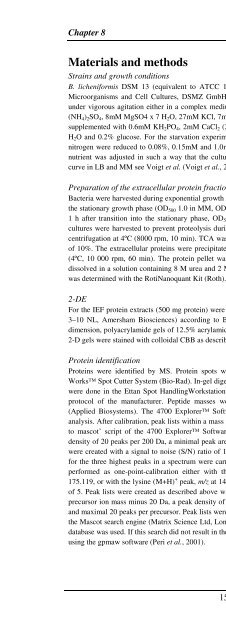The Staphylococcus aureus secretome - TI Pharma
The Staphylococcus aureus secretome - TI Pharma
The Staphylococcus aureus secretome - TI Pharma
You also want an ePaper? Increase the reach of your titles
YUMPU automatically turns print PDFs into web optimized ePapers that Google loves.
Chapter 8<br />
Materials and methods<br />
Strains and growth conditions<br />
B. licheniformis DSM 13 (equivalent to ATCC 14580, type strain from the German Collection of<br />
Microorganisms and Cell Cultures, DSMZ GmbH Braunschweig, Germany) was cultivated at 37ºC<br />
under vigorous agitation either in a complex medium (Luria Broth, LB) or in MM containing 15mM<br />
(NH4)2SO4, 8mM MgSO4 x 7 H2O, 27mM KCl, 7mM sodium citrate (2 H2O), 50mM Tris-HCl pH 7.5,<br />
supplemented with 0.6mM KH2PO4, 2mM CaCl2 (2 H2O), 1 mM FeSO4 x 7 H2O, 10 mM MnSO4 x 4<br />
H2O and 0.2% glucose. For the starvation experiments, the concentrations of glucose, phosphate and<br />
nitrogen were reduced to 0.08%, 0.15mM and 1.0mM, respectively. <strong>The</strong> concentration of the limiting<br />
nutrient was adjusted in such a way that the cultures grew to a maximum OD of about 1.0 (growth<br />
curve in LB and MM see Voigt et al. (Voigt et al., 2004)).<br />
Preparation of the extracellular protein fraction<br />
Bacteria were harvested during exponential growth (OD500 0.4 in MM, OD540 2.0 in LB), at the onset of<br />
the stationary growth phase (OD500 1.0 in MM, OD540 4.0 in LB) and during the stationary phase (MM<br />
1 h after transition into the stationary phase, OD540 6.0 in LB). PMSF (3mM) was added when the<br />
cultures were harvested to prevent proteolysis during sample preparation. <strong>The</strong> cells were removed by<br />
centrifugation at 4ºC (8000 rpm, 10 min). TCA was then added to the medium to a final concentration<br />
of 10%. <strong>The</strong> extracellular proteins were precipitated at 47C overnight and collected by centrifugation<br />
(4ºC, 10 000 rpm, 60 min). <strong>The</strong> protein pellet was washed eight times with 96% ethanol, dried and<br />
dissolved in a solution containing 8 M urea and 2 M thiourea. <strong>The</strong> protein concentration of the extract<br />
was determined with the RotiNanoquant Kit (Roth).<br />
2-DE<br />
For the IEF protein extracts (500 mg protein) were loaded onto commercially available IPG strips (pH<br />
3–10 NL, Amersham Biosciences) according to Büttner et al. (Büttner et al., 2001). In the second<br />
dimension, polyacrylamide gels of 12.5% acrylamide and 2.6% bisacrylamide were used. <strong>The</strong> resulting<br />
2-D gels were stained with colloidal CBB as described by Voigt et al. (Voigt et al., 2004).<br />
Protein identification<br />
Proteins were identified by MS. Protein spots were excised from stained gels with the Proteome<br />
Works Spot Cutter System (Bio-Rad). In-gel digestion with trypsin and the extraction of the peptides<br />
were done in the Ettan Spot HandlingWorkstation (Amersham Biosciences) according to a modified<br />
protocol of the manufacturer. Peptide masses were determined in the Proteomics Analyser 4700<br />
(Applied Biosystems). <strong>The</strong> 4700 Explorer Software V2.0 was used for spectrum calibration and<br />
analysis. After calibration, peak lists within a mass range of 900–3700 Da were created using the ’peak<br />
to mascot’ script of the 4700 Explorer Software. For the peak search, filters were set to a peak<br />
density of 20 peaks per 200 Da, a minimal peak area of 350 and maximal 60 peaks per spot. Peak lists<br />
were created with a signal to noise (S/N) ratio of 10 to 15. When necessary, TOF-TOF measurements<br />
for the three highest peaks in a spectrum were carried out. <strong>The</strong> internal calibration was automatically<br />
performed as one-point-calibration either with the mono- isotopic arginine (M+H) + peak, m/z at<br />
175.119, or with the lysine (M+H) + peak, m/z at 147.107, when the peaks reached at least an S/N ratio<br />
of 5. Peak lists were created as described above with the following settings: a mass range from 60 to<br />
precursor ion mass minus 20 Da, a peak density of five peaks per 200 Da, a minimal peak area of 100<br />
and maximal 20 peaks per precursor. Peak lists were created with an S/N ratio of 5. For database search<br />
the Mascot search engine (Matrix Science Ltd, London, UK) with a specific B. licheniformis sequence<br />
database was used. If this search did not result in the identification of the protein, PMF were reanalysed<br />
using the gpmaw software (Peri et al., 2001).<br />
152













